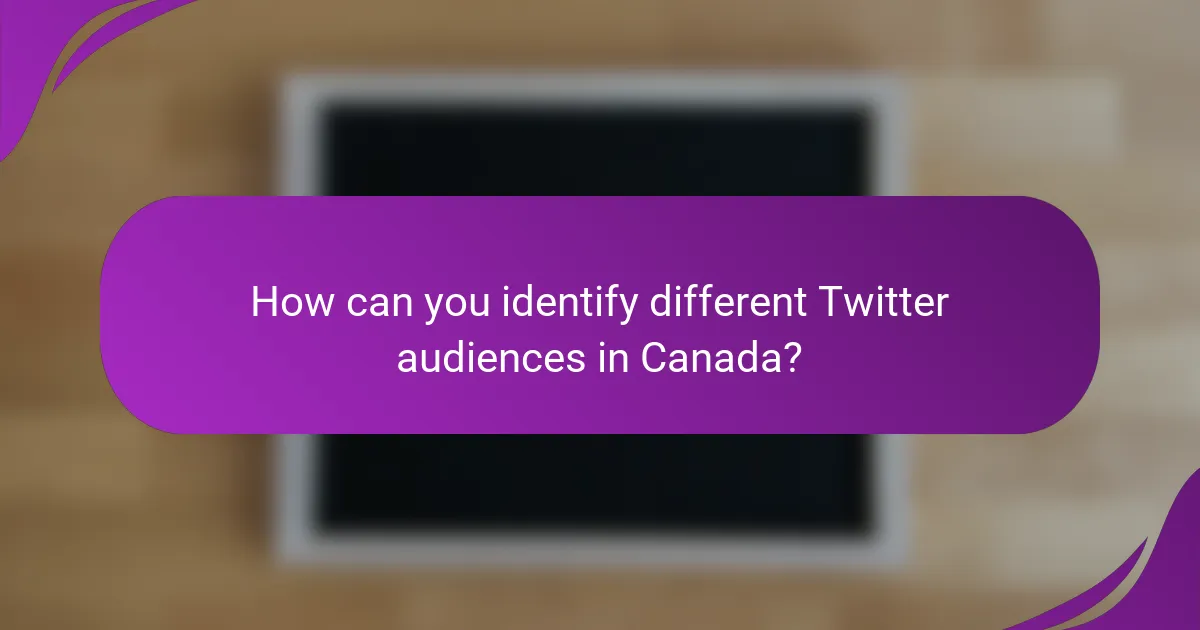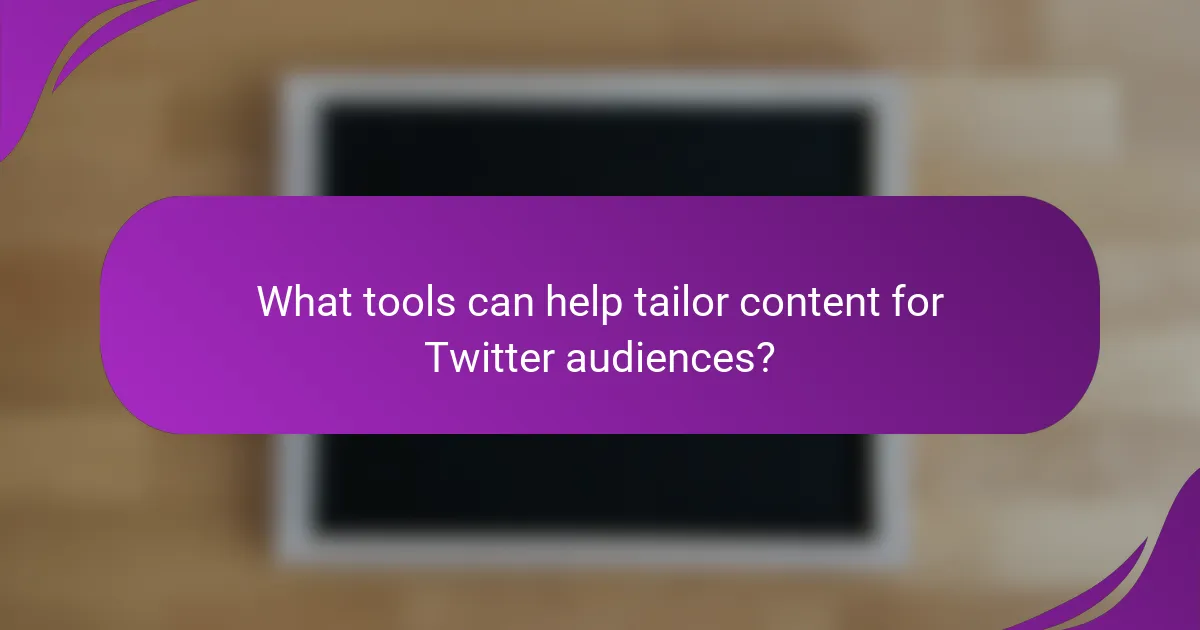To effectively engage with diverse Twitter audiences, it’s essential to analyze user demographics, interests, and behaviors. By tailoring your content to resonate with specific groups, you can enhance engagement and foster stronger connections. Focusing on localization and cultural relevance will further improve your messaging and interaction with followers.

How can you identify different Twitter audiences in Canada?
Identifying different Twitter audiences in Canada involves analyzing user demographics, interests, and behaviors. This understanding allows you to tailor content that resonates with specific groups, improving engagement and reach.
Use Twitter Analytics for audience insights
Twitter Analytics provides valuable data about your followers, including their locations, interests, and demographics. By accessing this tool, you can gain insights into who is engaging with your content and how they interact with your tweets.
Look for trends in follower growth and engagement rates to identify which audience segments are most responsive. This information can guide your content strategy, helping you create posts that appeal to specific demographics within Canada.
Analyze engagement metrics
Engagement metrics such as retweets, likes, and replies can reveal which types of content resonate with different audience segments. By examining these metrics, you can determine what topics or formats generate the most interaction from your Canadian followers.
Consider segmenting your audience based on engagement levels. For instance, high engagement on tweets about local events may indicate a strong interest in community-related content, while low engagement on promotional posts could suggest a need for more value-driven messaging.
Conduct audience surveys
Surveys can be an effective way to gather direct feedback from your Twitter audience in Canada. Use tools like Google Forms or Twitter polls to ask questions about their preferences, interests, and content types they enjoy.
Keep surveys concise and focused to encourage participation. Offering incentives, such as a chance to win a gift card, can increase response rates. Analyze the results to refine your content strategy based on the specific needs and desires of your audience segments.

What content strategies work best for Canadian Twitter audiences?
To effectively engage Canadian Twitter audiences, content strategies should focus on localization, cultural relevance, and tailored communication styles. Understanding regional preferences and incorporating local elements can significantly enhance audience connection and interaction.
Utilize localized hashtags
Localized hashtags are essential for reaching Canadian Twitter users. Using popular regional tags can increase visibility and engagement. For example, hashtags like #CanadaDay or #TorontoEvents resonate well with local audiences.
Research trending hashtags specific to Canadian cities or provinces to ensure your content is relevant. Tools like Twitter’s trending section or hashtag analytics can help identify these tags.
Incorporate cultural references
Integrating cultural references into your content can create a stronger bond with Canadian audiences. Mentioning local traditions, holidays, or current events can make your posts more relatable. For instance, referencing hockey during playoff season can spark interest and conversation.
Be mindful of the diverse cultural landscape in Canada, including Indigenous cultures and bilingual communities. Tailoring references to reflect this diversity can enhance engagement across different demographics.
Adapt tone and language for regional preferences
Adjusting your tone and language to suit Canadian audiences is crucial. Canadians often appreciate a friendly, polite tone that reflects their cultural values. Avoid overly aggressive marketing language and instead focus on building rapport.
Consider using Canadian English spellings and terms, such as “colour” instead of “color” or “favourite” instead of “favorite.” This small adjustment can make your content feel more familiar and appealing to the audience.

How can you segment your Twitter content for diverse audiences?
Segmenting your Twitter content for diverse audiences involves understanding the different groups that follow you and tailoring your messaging to meet their specific interests and needs. By creating targeted content, you can enhance engagement and foster a stronger connection with each audience segment.
Create audience personas
Creating audience personas helps you visualize and understand the characteristics of your different Twitter followers. Start by gathering data on demographics, interests, and behaviors to build profiles that represent your key audience segments.
For example, you might have personas for tech enthusiasts, lifestyle bloggers, and small business owners. Each persona will guide your content creation, ensuring it resonates with the specific interests and pain points of each group.
Use Twitter Lists for targeted messaging
Twitter Lists allow you to organize followers into specific groups, making it easier to share tailored content. By creating lists for different audience segments, you can monitor their tweets and engage with them more effectively.
For instance, if you have a list for industry influencers, you can share content that highlights trends or insights relevant to them. This targeted approach can lead to higher engagement rates and foster relationships with key individuals in your niche.
Schedule content based on audience activity
Scheduling your content to align with when your audience is most active can significantly improve visibility and engagement. Use Twitter analytics to identify peak activity times for each audience segment and plan your posts accordingly.
For example, if your lifestyle audience is most active in the evenings, schedule posts during that time. Tools like Buffer or Hootsuite can help automate this process, ensuring your content reaches the right people at the right time.

What tools can help tailor content for Twitter audiences?
Several tools can assist in tailoring content for different Twitter audiences, enhancing engagement and reach. Utilizing these tools effectively can help you analyze audience preferences, schedule posts, and create visually appealing content.
Hootsuite for scheduling and analytics
Hootsuite is a powerful platform for scheduling tweets and analyzing their performance. It allows users to plan posts in advance, ensuring consistent engagement with followers, even during off-hours. The analytics feature provides insights into audience interactions, helping you refine your content strategy.
When using Hootsuite, focus on key metrics such as engagement rates and click-through rates to understand what resonates with your audience. Regularly review these metrics to adjust your content accordingly and maximize impact.
Canva for visual content creation
Canva is an excellent tool for creating eye-catching visuals tailored for Twitter. With a wide range of templates and design elements, you can produce graphics that align with your brand and appeal to your audience’s tastes. Visual content often garners higher engagement compared to text-only posts.
To make the most of Canva, consider the dimensions of Twitter images and use high-contrast colors to enhance visibility. Incorporate your brand’s colors and fonts to maintain consistency across your posts.
BuzzSumo for trending topics
BuzzSumo helps identify trending topics and content that resonates with your target audience on Twitter. By analyzing what is currently popular, you can create timely and relevant tweets that capture attention. This tool can also provide insights into the types of content that perform best within your niche.
When using BuzzSumo, focus on engagement metrics such as shares and comments to gauge interest levels. Regularly check for emerging trends to stay ahead of the curve and keep your content fresh and engaging.

What metrics should you track for content effectiveness on Twitter?
To measure content effectiveness on Twitter, focus on engagement rate, click-through rate, and follower growth. These metrics provide insights into how well your content resonates with your audience and its impact on your overall Twitter strategy.
Engagement rate
Engagement rate measures the level of interaction your tweets receive relative to your total followers. This includes likes, retweets, replies, and mentions, giving you a clear picture of how engaging your content is.
A good engagement rate typically falls between 0.5% to 2%, but this can vary based on your industry and audience. Aim to create content that encourages interaction, such as questions or polls, to boost this metric.
Click-through rate
Click-through rate (CTR) indicates the percentage of users who click on links in your tweets compared to the total impressions. A higher CTR suggests that your content is compelling enough to drive traffic to your desired destination.
Generally, a CTR of 1% to 3% is considered effective on Twitter. To improve your CTR, use clear calls to action and ensure your links lead to valuable content that aligns with your audience’s interests.
Follower growth
Follower growth tracks the increase in your Twitter audience over time. This metric is crucial as it reflects your brand’s expanding reach and influence within your niche.
Consistent follower growth can vary widely, but aiming for a monthly increase of 2% to 5% is a reasonable target. To enhance follower growth, regularly share high-quality, relevant content and engage with your audience through replies and retweets.

How can you adjust your strategy based on audience feedback?
Adjusting your strategy based on audience feedback involves actively listening to your followers and modifying your content to better meet their preferences. This practice can enhance engagement and foster a stronger connection with your audience.
Analyze Engagement Metrics
Start by reviewing key engagement metrics such as likes, retweets, and replies to understand what resonates with your audience. Look for patterns in the types of content that generate the most interaction, whether it’s humor, informative posts, or visuals.
Consider using tools like Twitter Analytics to track these metrics over time. This will help you identify trends and shifts in audience preferences, allowing you to pivot your content strategy accordingly.
Solicit Direct Feedback
Encouraging direct feedback from your audience can provide valuable insights. Use polls or open-ended questions to ask followers what they enjoy or want to see more of. This not only engages your audience but also makes them feel valued.
For example, you might tweet a poll asking followers to choose between two content topics for your next post. This approach can lead to increased interaction and a clearer understanding of audience interests.
Test and Iterate
Implement A/B testing to compare different content formats or messaging styles. By posting variations and measuring their performance, you can determine which resonates best with your audience.
For instance, try posting a video versus a static image on the same topic and analyze which garners more engagement. Use these insights to refine your content strategy continuously.
Stay Flexible and Responsive
Being flexible in your content strategy is crucial. If you notice a significant shift in audience feedback, be prepared to adapt quickly. This responsiveness can help maintain engagement and relevance.
For example, if a particular hashtag or trend emerges, consider incorporating it into your content strategy to align with current audience interests. Regularly revisiting your approach ensures you remain in tune with your followers’ evolving preferences.
